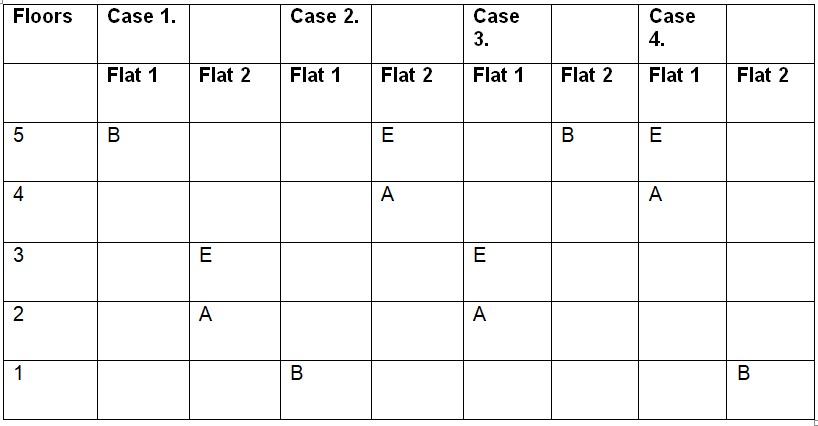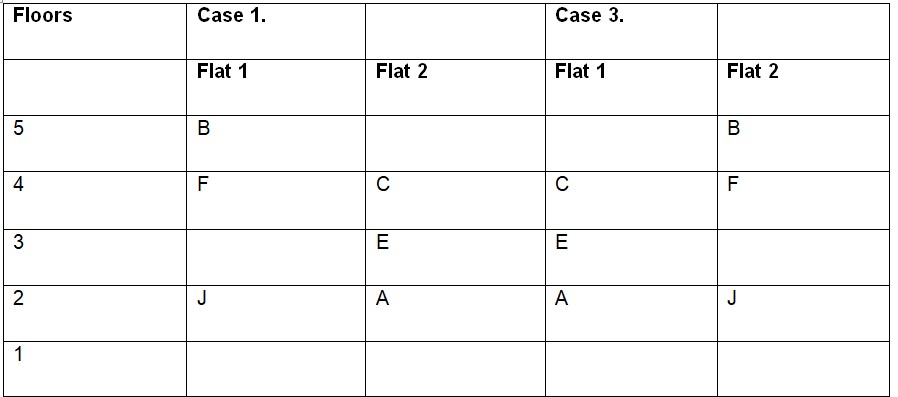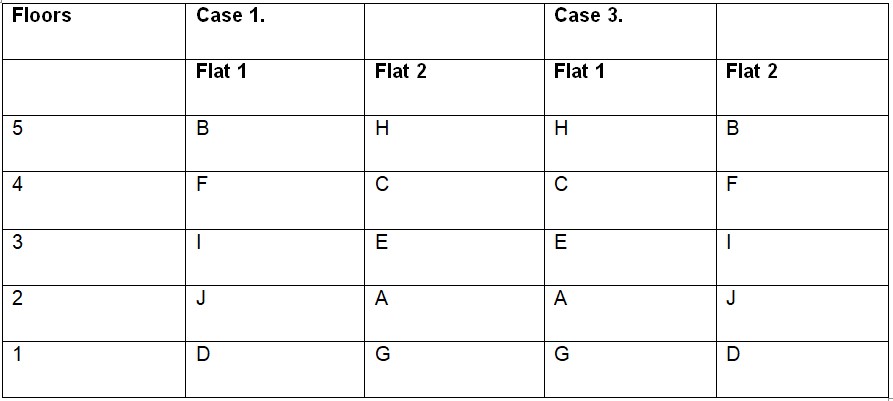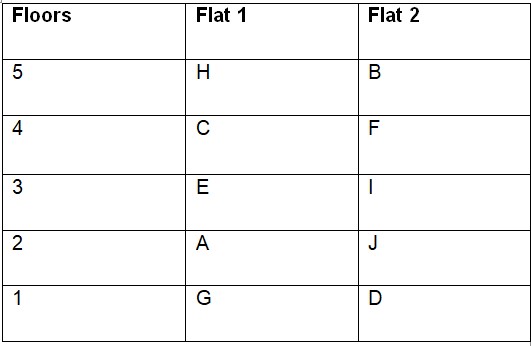Question
Who among the following lives in flat-2 of 4th
floor? Study the following information carefully to answer the given questions: Ten persons A, B, C, D, E, F, G, H, I and J are living in a five storey building such that ground floor is numbered as 1, above it is floor 2 then top floor is numbered as 5. Each of the floor has 2 flats in it as flat-1 and flat-2. Flat-1 of floor-2 is immediately above flat-1 of floor-1 and immediately below flat-1 of floor-3 and so on. In the same way flat-2 of floor-2 is immediately above flat-2 of floor-1 and immediately below flat-2 of floor-3 and so on. Flat-1 is in west of flat-2. B lives in an odd numbered floor. Both E and G lives in the same flat number. C and F live in the same floor. H does not live in flat number 2. There is a gap of two floors in which B and A lives. Both A and B do not live in the same flat number. E lives immediately above A in the same flat number. There is a gap of one floor in which E and G lives. J, who lives on an even numbered floor, lives below F and both lives in the same flat number. I lives above D and both live in the same flat number. H and D neither live in the same flat number nor in the same floor.Solution
B lives in an odd numbered floor. There is a gap of two floors in which B and A lives. Both A and B do not live in the same flat number. E lives immediately above A in the same flat number. From these statements we will have four cases: If B lives on fifth floor in flat 1, then A lives on second floor in flat 2. As E lives immediately above A in the same flat number. So, E will live on third floor in flat 2. If B lives on first floor in flat 1, then A lives on fourth floor in flat 2. As E lives immediately above A in the same flat number. So, E will live on fifth floor in flat 2. If B lives on fifth floor in flat 2, then A lives on second floor in flat 1. As E lives immediately above A in the same flat number. So, E will live on third floor in flat 1. If B lives on first floor in flat 2, then A lives on fourth floor in flat 1. As E lives immediately above A in the same flat number. So, E will live on fifth floor in flat 1.  Both E and G lives in the same flat number.C and F live in the same floor. (vi) J, who lives on an even numbered floor, lives below F and both lives in the same flat number. From these statements Case 2 and Case 4 will get discarded as G lives on third floor. C and F live on same floor and J lives below F in even number floor which can’t be possible. So, we will proceed with Case 1 and Case 3. Case 1. F cannot live on fourth floor in flat 2 as J lives below F in even number floor. So, F and C will live on fourth floor in flat 1 and flat 2 respectively. Then J lives on second floor in flat 1. Case 3. F cannot live on fourth floor in flat 1 as J lives below F in even number floor. So, F and C will live on fourth floor in flat 2 and flat 1 respectively. Then J lives on second floor in flat 2.
Both E and G lives in the same flat number.C and F live in the same floor. (vi) J, who lives on an even numbered floor, lives below F and both lives in the same flat number. From these statements Case 2 and Case 4 will get discarded as G lives on third floor. C and F live on same floor and J lives below F in even number floor which can’t be possible. So, we will proceed with Case 1 and Case 3. Case 1. F cannot live on fourth floor in flat 2 as J lives below F in even number floor. So, F and C will live on fourth floor in flat 1 and flat 2 respectively. Then J lives on second floor in flat 1. Case 3. F cannot live on fourth floor in flat 1 as J lives below F in even number floor. So, F and C will live on fourth floor in flat 2 and flat 1 respectively. Then J lives on second floor in flat 2.  H does not live in flat number 2.There is a gap of one floor in which E and G lives. I lives above D and both live in the same flat number. H and D neither live in the same flat number nor in the same floor. Case 1. I and D cannot live in flat 2 as there is a gap of one floor in which E and G lives. So, I and D will live on third floor and first floor in flat 1. H and D neither live in the same flat number nor in the same floor. H cannot live on first floor with D. So, H live son fifth floor in flat 2 but this case will get discarded as it is given that H does not live in flat number 2. Case 3. I and D cannot live in flat 1 as there is a gap of one floor in which E and G lives. So, I and D will live on third floor and first floor in flat 2. H and D neither live in the same flat number nor in the same floor. H cannot live on first floor with D. So, H live son fifth floor in flat 1 and G lives on first floor in flat 1.
H does not live in flat number 2.There is a gap of one floor in which E and G lives. I lives above D and both live in the same flat number. H and D neither live in the same flat number nor in the same floor. Case 1. I and D cannot live in flat 2 as there is a gap of one floor in which E and G lives. So, I and D will live on third floor and first floor in flat 1. H and D neither live in the same flat number nor in the same floor. H cannot live on first floor with D. So, H live son fifth floor in flat 2 but this case will get discarded as it is given that H does not live in flat number 2. Case 3. I and D cannot live in flat 1 as there is a gap of one floor in which E and G lives. So, I and D will live on third floor and first floor in flat 2. H and D neither live in the same flat number nor in the same floor. H cannot live on first floor with D. So, H live son fifth floor in flat 1 and G lives on first floor in flat 1.  Final arrangement as shown below:
Final arrangement as shown below: 
Three cards are drawn randomly from a pack of 52 cards. What is the probability that one will be black and two will be red?
If the letter of the word Apples is arranged at random, what is the probability that all the vowels comes together?
- A bag contains ‘x’ blue balls and 5 yellow balls. If the probability of getting a blue ball is 2/3, then find the probability of getting different colo...
In a lottery, there are 6 prizes and 30 blanks. A lottery is drawn at random. What is the probability of getting a prize?
...Two hats are picked at random, what is the probability that all hats are of green colour?
A bag contains 10 black and 12 white balls. One ball is drawn at random. What is the probability that the ball drawn is white?
A bag contains 12 black and 14 white balls. One ball is drawn at random. What is the probability that the ball drawn is white?
...A game consists of tossing three coins once and then rolling two dice. Find the probability of getting exactly one tail in the coin toss and a sum equal...
A box contains 6 red, 5 green, and 4 blue balls. Two balls are drawn randomly. What is the probability that they are of different colors?
- A piggy bank has seven 25 paise coins, five Rs. 2 coins, and thirteen Rs. 5 coins. One of the coins fell and got lost. Find the probability that the lost c...
Relevant for Exams:


